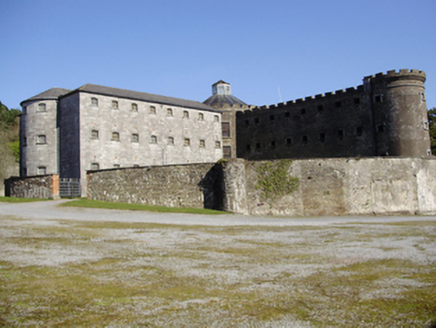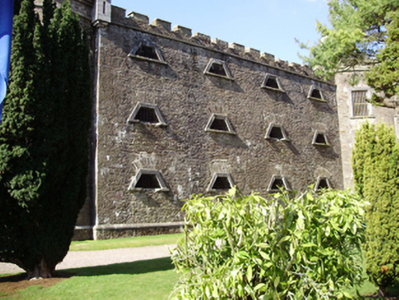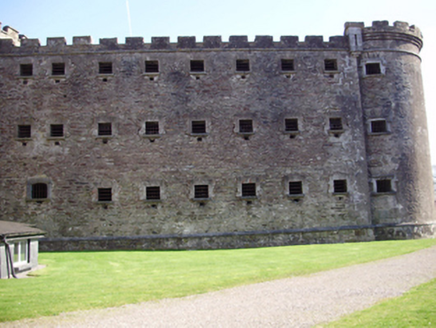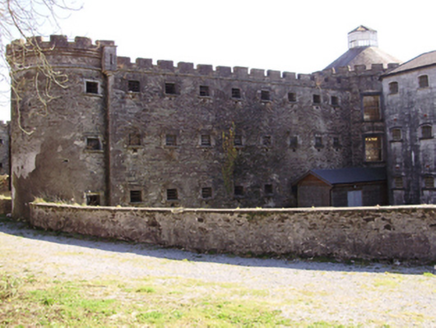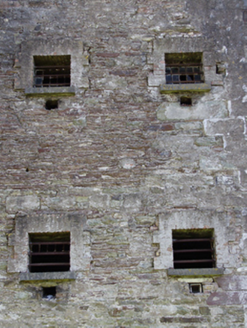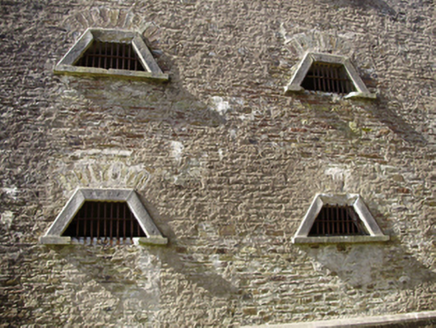Survey Data
Reg No
20866007
Rating
National
Categories of Special Interest
Architectural, Historical, Social
Original Use
Prison/jail
In Use As
Heritage centre/interpretative centre
Date
1815 - 1825
Coordinates
165678, 71979
Date Recorded
15/03/2011
Date Updated
--/--/--
Description
Detached H-plan former gaol, built 1818-24, now partly in use as heritage centre. Western section comprises central three-storey circular drum gallery with six-bay three-storey single-sided cell blocks extending to north and south with terminating three-storey D-shaped towers to ends. Remodelled cell block to west. Roof not visible behind crenellated parapet with cut limestone stringcourse and mock bartizan to corners, dome slate roof to drum gallery with timber cupola, some cast-iron rainwater goods. Roughcast rendered walls, exposed rubble walls in sections, with cut limestone quoins and plinth course. Square-headed window openings to west elevation with brick block-and-start surrounds and cut limestone sills. Triangular openings to east elevation with cut limestone surrounds and sills. Square-headed window openings to connecting gallery and terminating towers with cut limestone surrounds and sills, label mouldings to terminating towers. Wrought-iron bars to openings. Segmental-headed door opening to connecting gallery with cut limestone surround having overlight, timber panelled door, wrought-iron bars and accessed via cut limestone steps.
Appraisal
A large-scale former gaol, designed in the Georgian Gothic style, in a form more commonly associated with a castle than a purposely built prison. Designed by architect Sir Thomas Dean, work commenced in 1818 and its first inmates were admitted in 1824. Its castellated style and towers indicate the building's fortress-like function. The plain façade and austerity of the cell wings is relieved by end towers and cut limestone window surrounds. The former hospital and debtors' prison complete the site. Throughout the 1820s and 30s many prisoners were detained at the site while awaiting transportation to Australia. Ralph and Isaac Varian, Denny Lane, and Terence Bellew McManus are among the Young Irelanders who were incarcerated in the 1840s, while James Mountaine, John Sarsfield Casey and Brian Dillon, were Fenians who were held in the 1860s. The west wing was remodelled in 1870 and is an interesting example of the changing theories in incarceration. By 1878, it was a women’s prison, and Hannah Reynolds, a Land League supporter was imprisoned in the 1880s, while Countess Markievicz was held in the 1900s. In 1922-3, male anti-treaty supporters were imprisoned, including Jim Hurley, Frank O'Connor, Mary Bowles, Todd Andrews and Sean McCarthy. It ceased to operate as a prison in August 1923.
